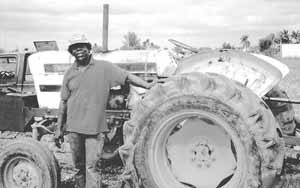
Vol.63/No.41 November 22, 1999
Florida farmers, farm workers confront hurricane aftermath

Militant
Harvey Johnson had to replant entire crop.
Government relief is uncertain.
BY ERIC SIMPSON AND ROLLANDE GIRARD
HOMESTEAD, Florida — "I lost all my crop to Hurricane Irene," said Harvey Johnson. "I have to start all over again." Hurricane Irene hit this town south of Miami October 15.
Johnson rents 175 acres of land, where he plants green beans and okra. "I planted again but I might still lose it to a freeze because it is so late," he said. He said he is one of the Black farmers who cultivates the most land in the area, but his farm is small compared to local white farmers.
Johnson, who has been farming since 1985, has filed for Federal government emergency aid. Government officials in Florida estimate that six counties in the state lost $400 million worth of crops to Hurricane Irene's flooding and high winds. Ninety-five percent of the vegetable crop in the Homestead area was destroyed. Johnson doesn't know if he will get money, or when.
He described the situation as a vegetable farmer. "We have no guarantee on how much we will get for the crate of beans; a break-even price would be $10," he said. "We spend $1.53 for each box, $4.50 to pick the beans, and $1.35 to keep each crate in the cooler before it gets sold."
On top of this, Johnson pays $300 to $400 per acre per year to an absentee landlord to rent the land. And "in Florida you need to spray every week against the many different illnesses," he explained.
Farm workers have also been seriously affected. Many of them face two months without work and are not eligible to receive unemployment benefits. Miami Dade County and United Way contributed $250,000 in emergency aid. "This is not enough," explained Francisco Garza, a leader of the Farm workers Association of Florida. "Around 8,000 families are in this same situation." The aid comes in the form of food donations and checks of up to $500 per month per family to pay rent and utility bills. According to the Miami Herald, the quota of 1, 000 cases was met within days.
The Herald reported that on some days aid workers have turned away dozens of farm workers because of lack of funds. One bus load of Haitian laborers was turned away recently.
When Hurricane Irene hit South Florida, it was the beginning of the winter season when most migrant laborers come to the area for employment. Seventy percent of the green beans sold in the United States are grown in South Florida.
Some workers had come down early from North Carolina, out of work because of the flooding there.
Garza said a rumor circulated that Red Cross workers were questioning people about their immigration status, so "people stayed home and we had to go tell them there was no danger they would be deported." Government funds are only available to documented workers, but aid from private agencies like the Red Cross can be given to anyone.
As the hurricane was destroying South Florida's crops, many farm workers drove 20 hours up to Washington, D.C., and back to join a protest of 5,000 people demanding a halt to deportation and status for all immigrants.
Eric Simpson is a member of Union of Needletrades, Industrial and Textile Employees Local 415. Rollande Girard is a member of International Association of Machinists Local 1126.
Front page (for this issue) |
Home |
Text-version home